Exploring the Socio-Economic Role of Women in Cumnor in the 1860s
VerifiedAdded on 2023/06/09
|10
|3568
|379
Essay
AI Summary
This essay examines the role of women in Cumnor during the 1860s, a period characterized by significant gender inequality and limited opportunities for women. The primary occupations available to women were school teaching and domestic service, reflecting broader societal expectations of female subservience. In Cumnor, a village largely dependent on agriculture and animal husbandry, women's employment was often tied to domestic outwork, such as laundry. While some women migrated to industrial centers for work in textile mills and other factories, they faced discrimination and low wages. The study also highlights the impact of economic hardship on families, often necessitating women's participation in the workforce to compensate for injured or deceased husbands. Despite these challenges, women in Cumnor demonstrated resilience and adaptability in contributing to their families' livelihoods within the constraints of their time.
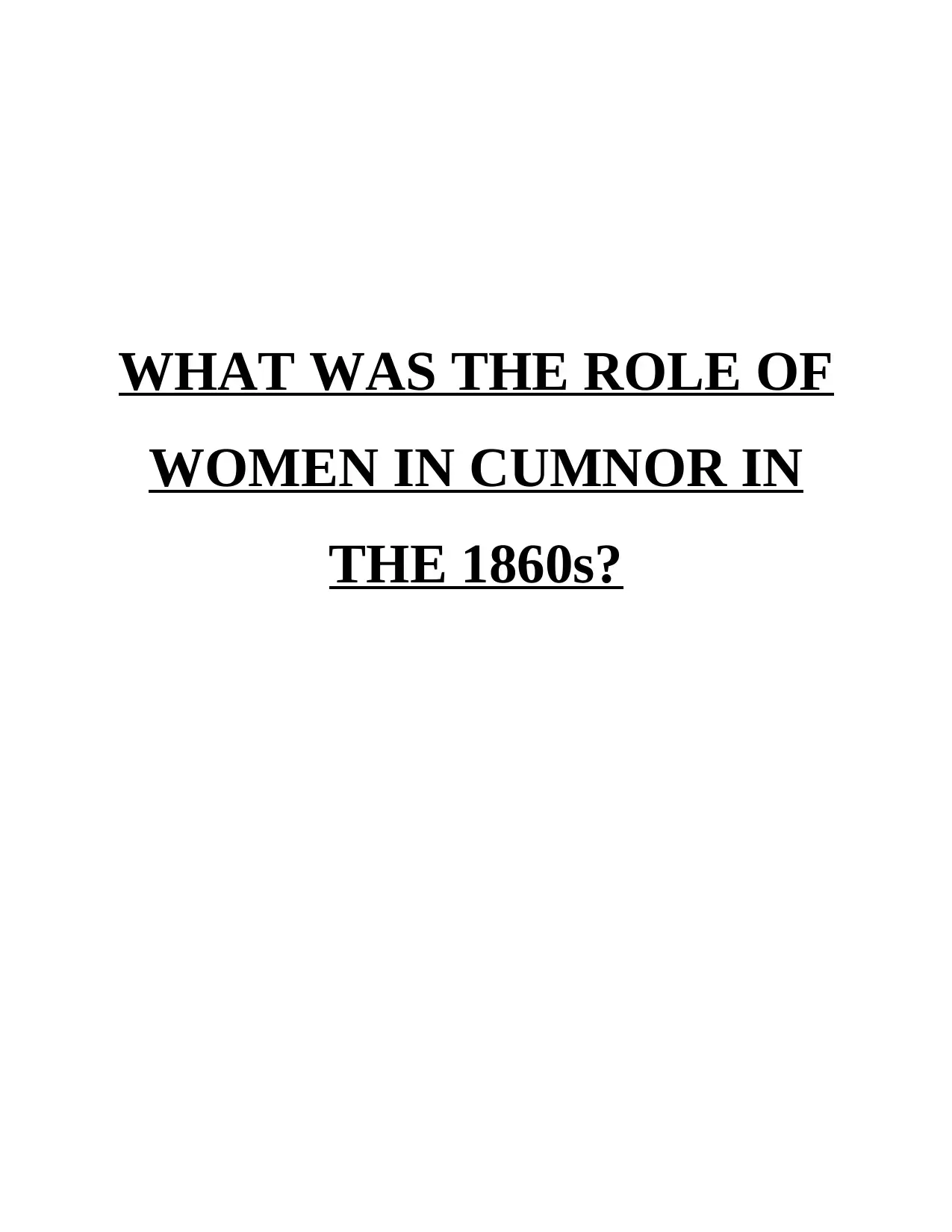
WHAT WAS THE ROLE OF
WOMEN IN CUMNOR IN
THE 1860s?
WOMEN IN CUMNOR IN
THE 1860s?
Paraphrase This Document
Need a fresh take? Get an instant paraphrase of this document with our AI Paraphraser

Table of Contents
INTRODUCTION...........................................................................................................................3
MAIN BODY...................................................................................................................................3
Role of Women in Cumnor in 1860.............................................................................................3
CONCLUSION................................................................................................................................9
INTRODUCTION...........................................................................................................................3
MAIN BODY...................................................................................................................................3
Role of Women in Cumnor in 1860.............................................................................................3
CONCLUSION................................................................................................................................9
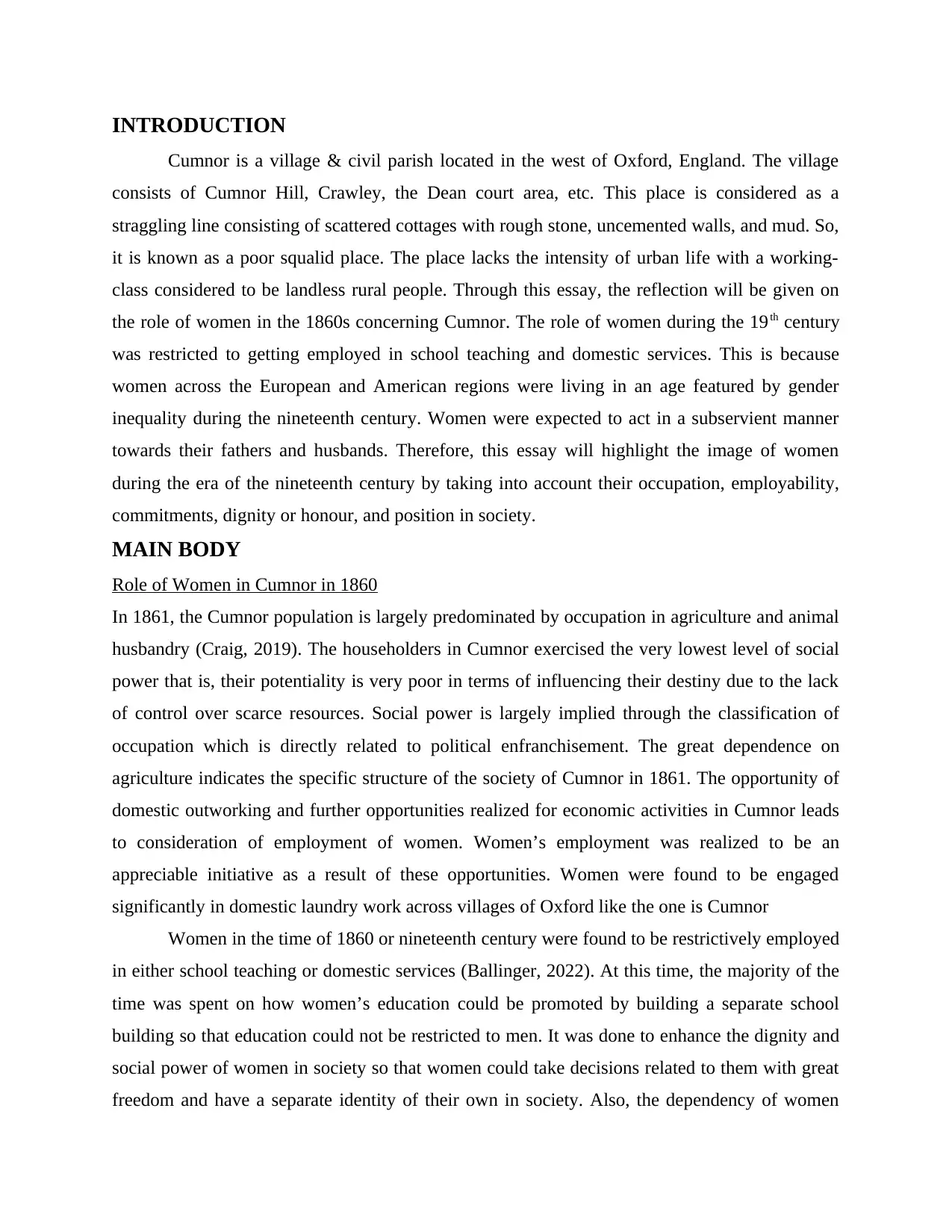
INTRODUCTION
Cumnor is a village & civil parish located in the west of Oxford, England. The village
consists of Cumnor Hill, Crawley, the Dean court area, etc. This place is considered as a
straggling line consisting of scattered cottages with rough stone, uncemented walls, and mud. So,
it is known as a poor squalid place. The place lacks the intensity of urban life with a working-
class considered to be landless rural people. Through this essay, the reflection will be given on
the role of women in the 1860s concerning Cumnor. The role of women during the 19th century
was restricted to getting employed in school teaching and domestic services. This is because
women across the European and American regions were living in an age featured by gender
inequality during the nineteenth century. Women were expected to act in a subservient manner
towards their fathers and husbands. Therefore, this essay will highlight the image of women
during the era of the nineteenth century by taking into account their occupation, employability,
commitments, dignity or honour, and position in society.
MAIN BODY
Role of Women in Cumnor in 1860
In 1861, the Cumnor population is largely predominated by occupation in agriculture and animal
husbandry (Craig, 2019). The householders in Cumnor exercised the very lowest level of social
power that is, their potentiality is very poor in terms of influencing their destiny due to the lack
of control over scarce resources. Social power is largely implied through the classification of
occupation which is directly related to political enfranchisement. The great dependence on
agriculture indicates the specific structure of the society of Cumnor in 1861. The opportunity of
domestic outworking and further opportunities realized for economic activities in Cumnor leads
to consideration of employment of women. Women’s employment was realized to be an
appreciable initiative as a result of these opportunities. Women were found to be engaged
significantly in domestic laundry work across villages of Oxford like the one is Cumnor
Women in the time of 1860 or nineteenth century were found to be restrictively employed
in either school teaching or domestic services (Ballinger, 2022). At this time, the majority of the
time was spent on how women’s education could be promoted by building a separate school
building so that education could not be restricted to men. It was done to enhance the dignity and
social power of women in society so that women could take decisions related to them with great
freedom and have a separate identity of their own in society. Also, the dependency of women
Cumnor is a village & civil parish located in the west of Oxford, England. The village
consists of Cumnor Hill, Crawley, the Dean court area, etc. This place is considered as a
straggling line consisting of scattered cottages with rough stone, uncemented walls, and mud. So,
it is known as a poor squalid place. The place lacks the intensity of urban life with a working-
class considered to be landless rural people. Through this essay, the reflection will be given on
the role of women in the 1860s concerning Cumnor. The role of women during the 19th century
was restricted to getting employed in school teaching and domestic services. This is because
women across the European and American regions were living in an age featured by gender
inequality during the nineteenth century. Women were expected to act in a subservient manner
towards their fathers and husbands. Therefore, this essay will highlight the image of women
during the era of the nineteenth century by taking into account their occupation, employability,
commitments, dignity or honour, and position in society.
MAIN BODY
Role of Women in Cumnor in 1860
In 1861, the Cumnor population is largely predominated by occupation in agriculture and animal
husbandry (Craig, 2019). The householders in Cumnor exercised the very lowest level of social
power that is, their potentiality is very poor in terms of influencing their destiny due to the lack
of control over scarce resources. Social power is largely implied through the classification of
occupation which is directly related to political enfranchisement. The great dependence on
agriculture indicates the specific structure of the society of Cumnor in 1861. The opportunity of
domestic outworking and further opportunities realized for economic activities in Cumnor leads
to consideration of employment of women. Women’s employment was realized to be an
appreciable initiative as a result of these opportunities. Women were found to be engaged
significantly in domestic laundry work across villages of Oxford like the one is Cumnor
Women in the time of 1860 or nineteenth century were found to be restrictively employed
in either school teaching or domestic services (Ballinger, 2022). At this time, the majority of the
time was spent on how women’s education could be promoted by building a separate school
building so that education could not be restricted to men. It was done to enhance the dignity and
social power of women in society so that women could take decisions related to them with great
freedom and have a separate identity of their own in society. Also, the dependency of women
⊘ This is a preview!⊘
Do you want full access?
Subscribe today to unlock all pages.

Trusted by 1+ million students worldwide
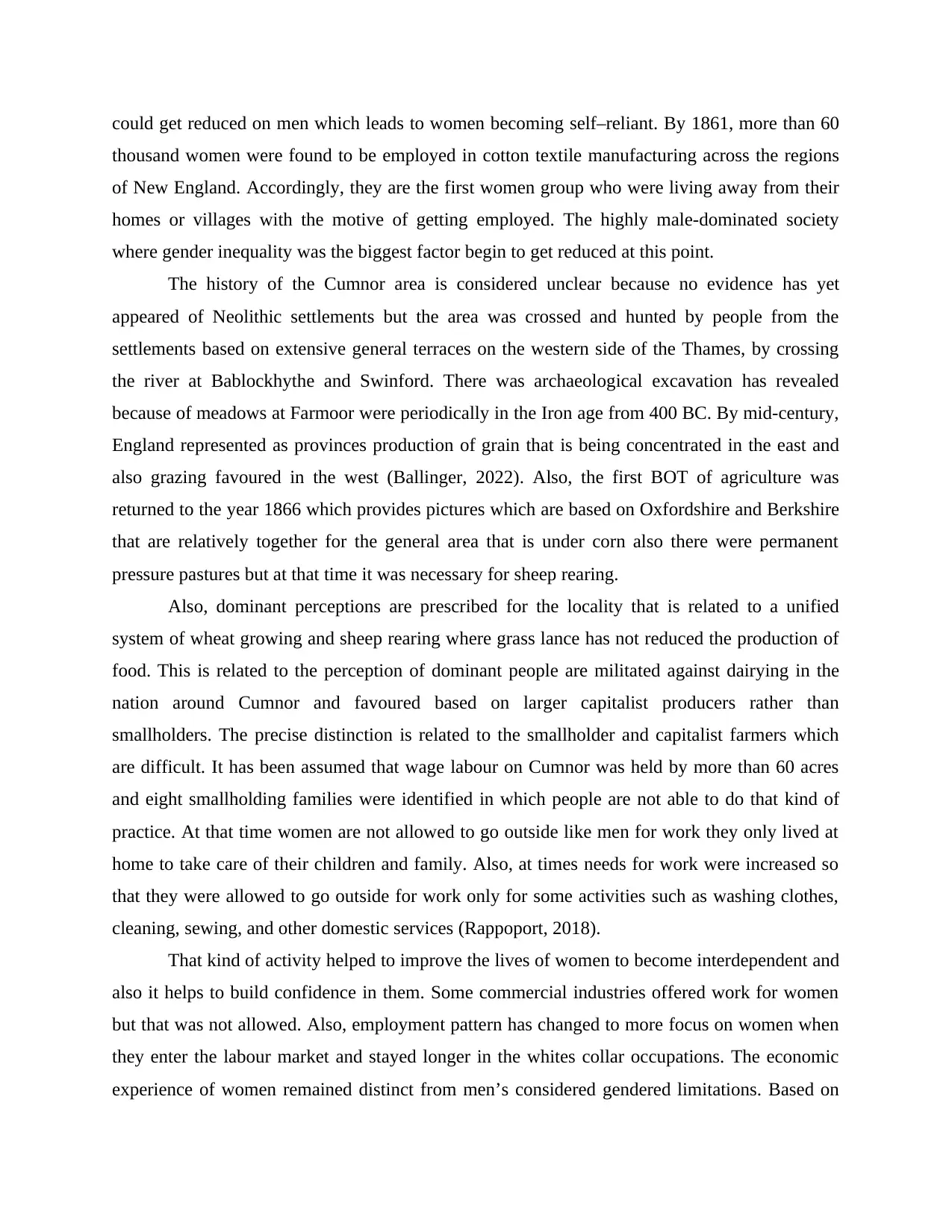
could get reduced on men which leads to women becoming self–reliant. By 1861, more than 60
thousand women were found to be employed in cotton textile manufacturing across the regions
of New England. Accordingly, they are the first women group who were living away from their
homes or villages with the motive of getting employed. The highly male-dominated society
where gender inequality was the biggest factor begin to get reduced at this point.
The history of the Cumnor area is considered unclear because no evidence has yet
appeared of Neolithic settlements but the area was crossed and hunted by people from the
settlements based on extensive general terraces on the western side of the Thames, by crossing
the river at Bablockhythe and Swinford. There was archaeological excavation has revealed
because of meadows at Farmoor were periodically in the Iron age from 400 BC. By mid-century,
England represented as provinces production of grain that is being concentrated in the east and
also grazing favoured in the west (Ballinger, 2022). Also, the first BOT of agriculture was
returned to the year 1866 which provides pictures which are based on Oxfordshire and Berkshire
that are relatively together for the general area that is under corn also there were permanent
pressure pastures but at that time it was necessary for sheep rearing.
Also, dominant perceptions are prescribed for the locality that is related to a unified
system of wheat growing and sheep rearing where grass lance has not reduced the production of
food. This is related to the perception of dominant people are militated against dairying in the
nation around Cumnor and favoured based on larger capitalist producers rather than
smallholders. The precise distinction is related to the smallholder and capitalist farmers which
are difficult. It has been assumed that wage labour on Cumnor was held by more than 60 acres
and eight smallholding families were identified in which people are not able to do that kind of
practice. At that time women are not allowed to go outside like men for work they only lived at
home to take care of their children and family. Also, at times needs for work were increased so
that they were allowed to go outside for work only for some activities such as washing clothes,
cleaning, sewing, and other domestic services (Rappoport, 2018).
That kind of activity helped to improve the lives of women to become interdependent and
also it helps to build confidence in them. Some commercial industries offered work for women
but that was not allowed. Also, employment pattern has changed to more focus on women when
they enter the labour market and stayed longer in the whites collar occupations. The economic
experience of women remained distinct from men’s considered gendered limitations. Based on
thousand women were found to be employed in cotton textile manufacturing across the regions
of New England. Accordingly, they are the first women group who were living away from their
homes or villages with the motive of getting employed. The highly male-dominated society
where gender inequality was the biggest factor begin to get reduced at this point.
The history of the Cumnor area is considered unclear because no evidence has yet
appeared of Neolithic settlements but the area was crossed and hunted by people from the
settlements based on extensive general terraces on the western side of the Thames, by crossing
the river at Bablockhythe and Swinford. There was archaeological excavation has revealed
because of meadows at Farmoor were periodically in the Iron age from 400 BC. By mid-century,
England represented as provinces production of grain that is being concentrated in the east and
also grazing favoured in the west (Ballinger, 2022). Also, the first BOT of agriculture was
returned to the year 1866 which provides pictures which are based on Oxfordshire and Berkshire
that are relatively together for the general area that is under corn also there were permanent
pressure pastures but at that time it was necessary for sheep rearing.
Also, dominant perceptions are prescribed for the locality that is related to a unified
system of wheat growing and sheep rearing where grass lance has not reduced the production of
food. This is related to the perception of dominant people are militated against dairying in the
nation around Cumnor and favoured based on larger capitalist producers rather than
smallholders. The precise distinction is related to the smallholder and capitalist farmers which
are difficult. It has been assumed that wage labour on Cumnor was held by more than 60 acres
and eight smallholding families were identified in which people are not able to do that kind of
practice. At that time women are not allowed to go outside like men for work they only lived at
home to take care of their children and family. Also, at times needs for work were increased so
that they were allowed to go outside for work only for some activities such as washing clothes,
cleaning, sewing, and other domestic services (Rappoport, 2018).
That kind of activity helped to improve the lives of women to become interdependent and
also it helps to build confidence in them. Some commercial industries offered work for women
but that was not allowed. Also, employment pattern has changed to more focus on women when
they enter the labour market and stayed longer in the whites collar occupations. The economic
experience of women remained distinct from men’s considered gendered limitations. Based on
Paraphrase This Document
Need a fresh take? Get an instant paraphrase of this document with our AI Paraphraser
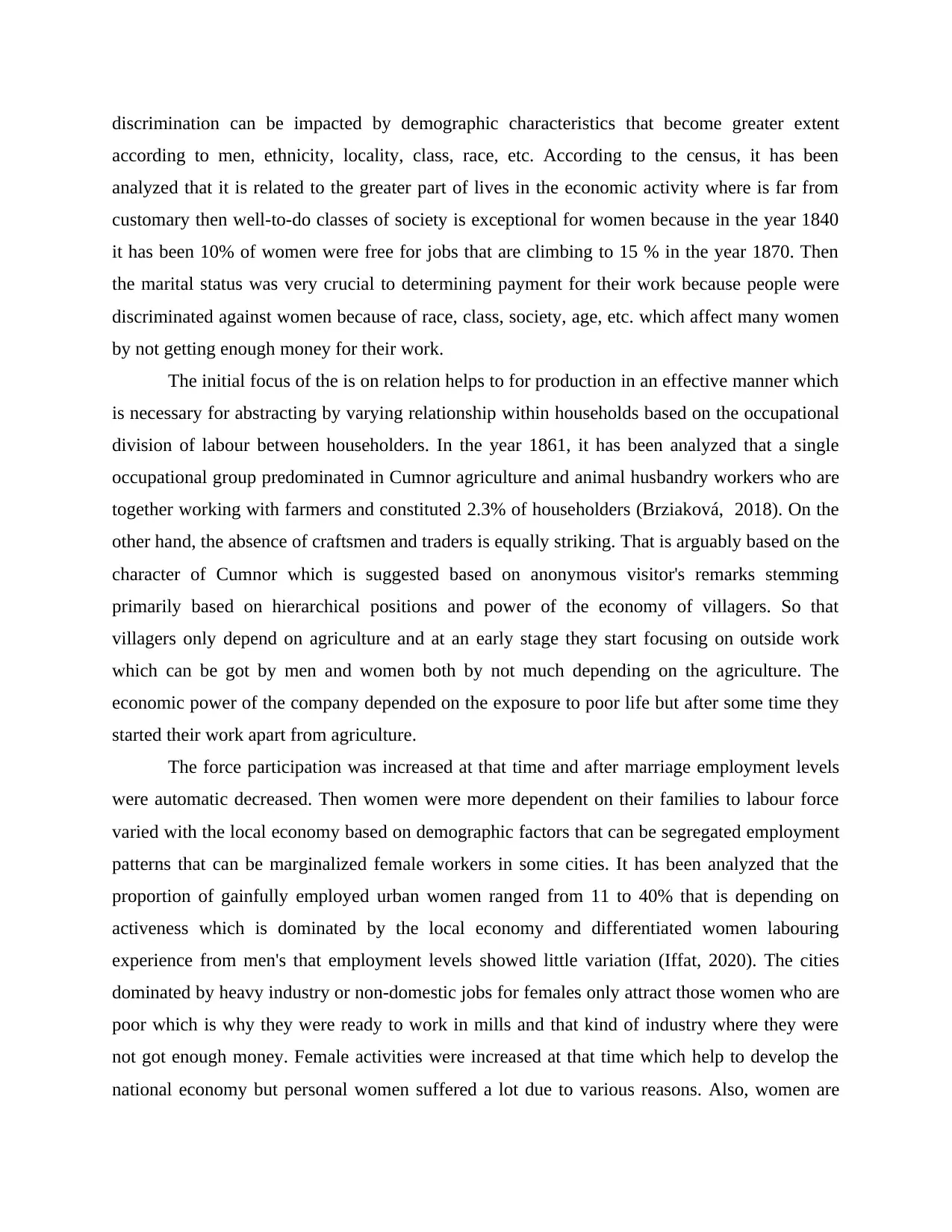
discrimination can be impacted by demographic characteristics that become greater extent
according to men, ethnicity, locality, class, race, etc. According to the census, it has been
analyzed that it is related to the greater part of lives in the economic activity where is far from
customary then well-to-do classes of society is exceptional for women because in the year 1840
it has been 10% of women were free for jobs that are climbing to 15 % in the year 1870. Then
the marital status was very crucial to determining payment for their work because people were
discriminated against women because of race, class, society, age, etc. which affect many women
by not getting enough money for their work.
The initial focus of the is on relation helps to for production in an effective manner which
is necessary for abstracting by varying relationship within households based on the occupational
division of labour between householders. In the year 1861, it has been analyzed that a single
occupational group predominated in Cumnor agriculture and animal husbandry workers who are
together working with farmers and constituted 2.3% of householders (Brziaková, 2018). On the
other hand, the absence of craftsmen and traders is equally striking. That is arguably based on the
character of Cumnor which is suggested based on anonymous visitor's remarks stemming
primarily based on hierarchical positions and power of the economy of villagers. So that
villagers only depend on agriculture and at an early stage they start focusing on outside work
which can be got by men and women both by not much depending on the agriculture. The
economic power of the company depended on the exposure to poor life but after some time they
started their work apart from agriculture.
The force participation was increased at that time and after marriage employment levels
were automatic decreased. Then women were more dependent on their families to labour force
varied with the local economy based on demographic factors that can be segregated employment
patterns that can be marginalized female workers in some cities. It has been analyzed that the
proportion of gainfully employed urban women ranged from 11 to 40% that is depending on
activeness which is dominated by the local economy and differentiated women labouring
experience from men's that employment levels showed little variation (Iffat, 2020). The cities
dominated by heavy industry or non-domestic jobs for females only attract those women who are
poor which is why they were ready to work in mills and that kind of industry where they were
not got enough money. Female activities were increased at that time which help to develop the
national economy but personal women suffered a lot due to various reasons. Also, women are
according to men, ethnicity, locality, class, race, etc. According to the census, it has been
analyzed that it is related to the greater part of lives in the economic activity where is far from
customary then well-to-do classes of society is exceptional for women because in the year 1840
it has been 10% of women were free for jobs that are climbing to 15 % in the year 1870. Then
the marital status was very crucial to determining payment for their work because people were
discriminated against women because of race, class, society, age, etc. which affect many women
by not getting enough money for their work.
The initial focus of the is on relation helps to for production in an effective manner which
is necessary for abstracting by varying relationship within households based on the occupational
division of labour between householders. In the year 1861, it has been analyzed that a single
occupational group predominated in Cumnor agriculture and animal husbandry workers who are
together working with farmers and constituted 2.3% of householders (Brziaková, 2018). On the
other hand, the absence of craftsmen and traders is equally striking. That is arguably based on the
character of Cumnor which is suggested based on anonymous visitor's remarks stemming
primarily based on hierarchical positions and power of the economy of villagers. So that
villagers only depend on agriculture and at an early stage they start focusing on outside work
which can be got by men and women both by not much depending on the agriculture. The
economic power of the company depended on the exposure to poor life but after some time they
started their work apart from agriculture.
The force participation was increased at that time and after marriage employment levels
were automatic decreased. Then women were more dependent on their families to labour force
varied with the local economy based on demographic factors that can be segregated employment
patterns that can be marginalized female workers in some cities. It has been analyzed that the
proportion of gainfully employed urban women ranged from 11 to 40% that is depending on
activeness which is dominated by the local economy and differentiated women labouring
experience from men's that employment levels showed little variation (Iffat, 2020). The cities
dominated by heavy industry or non-domestic jobs for females only attract those women who are
poor which is why they were ready to work in mills and that kind of industry where they were
not got enough money. Female activities were increased at that time which help to develop the
national economy but personal women suffered a lot due to various reasons. Also, women are
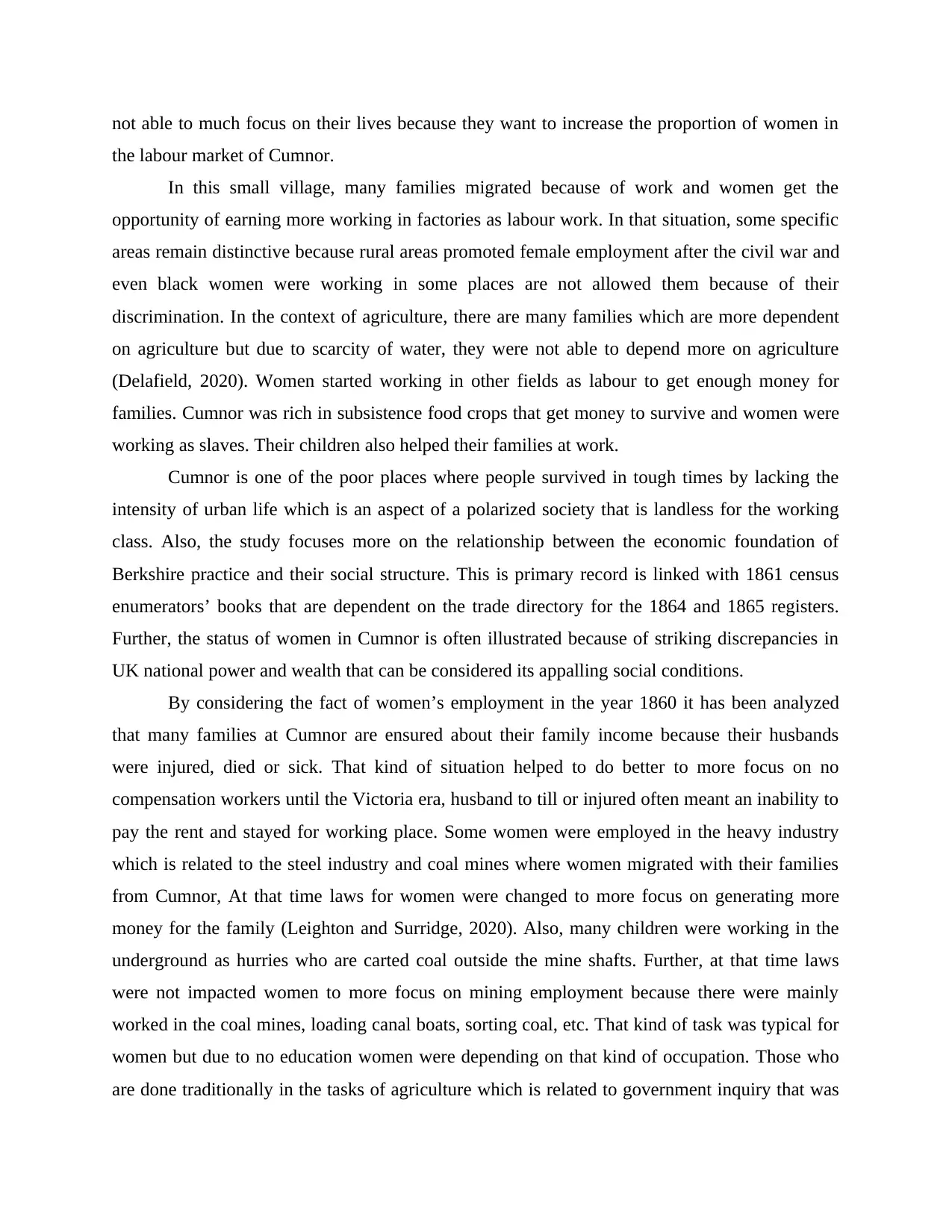
not able to much focus on their lives because they want to increase the proportion of women in
the labour market of Cumnor.
In this small village, many families migrated because of work and women get the
opportunity of earning more working in factories as labour work. In that situation, some specific
areas remain distinctive because rural areas promoted female employment after the civil war and
even black women were working in some places are not allowed them because of their
discrimination. In the context of agriculture, there are many families which are more dependent
on agriculture but due to scarcity of water, they were not able to depend more on agriculture
(Delafield, 2020). Women started working in other fields as labour to get enough money for
families. Cumnor was rich in subsistence food crops that get money to survive and women were
working as slaves. Their children also helped their families at work.
Cumnor is one of the poor places where people survived in tough times by lacking the
intensity of urban life which is an aspect of a polarized society that is landless for the working
class. Also, the study focuses more on the relationship between the economic foundation of
Berkshire practice and their social structure. This is primary record is linked with 1861 census
enumerators’ books that are dependent on the trade directory for the 1864 and 1865 registers.
Further, the status of women in Cumnor is often illustrated because of striking discrepancies in
UK national power and wealth that can be considered its appalling social conditions.
By considering the fact of women’s employment in the year 1860 it has been analyzed
that many families at Cumnor are ensured about their family income because their husbands
were injured, died or sick. That kind of situation helped to do better to more focus on no
compensation workers until the Victoria era, husband to till or injured often meant an inability to
pay the rent and stayed for working place. Some women were employed in the heavy industry
which is related to the steel industry and coal mines where women migrated with their families
from Cumnor, At that time laws for women were changed to more focus on generating more
money for the family (Leighton and Surridge, 2020). Also, many children were working in the
underground as hurries who are carted coal outside the mine shafts. Further, at that time laws
were not impacted women to more focus on mining employment because there were mainly
worked in the coal mines, loading canal boats, sorting coal, etc. That kind of task was typical for
women but due to no education women were depending on that kind of occupation. Those who
are done traditionally in the tasks of agriculture which is related to government inquiry that was
the labour market of Cumnor.
In this small village, many families migrated because of work and women get the
opportunity of earning more working in factories as labour work. In that situation, some specific
areas remain distinctive because rural areas promoted female employment after the civil war and
even black women were working in some places are not allowed them because of their
discrimination. In the context of agriculture, there are many families which are more dependent
on agriculture but due to scarcity of water, they were not able to depend more on agriculture
(Delafield, 2020). Women started working in other fields as labour to get enough money for
families. Cumnor was rich in subsistence food crops that get money to survive and women were
working as slaves. Their children also helped their families at work.
Cumnor is one of the poor places where people survived in tough times by lacking the
intensity of urban life which is an aspect of a polarized society that is landless for the working
class. Also, the study focuses more on the relationship between the economic foundation of
Berkshire practice and their social structure. This is primary record is linked with 1861 census
enumerators’ books that are dependent on the trade directory for the 1864 and 1865 registers.
Further, the status of women in Cumnor is often illustrated because of striking discrepancies in
UK national power and wealth that can be considered its appalling social conditions.
By considering the fact of women’s employment in the year 1860 it has been analyzed
that many families at Cumnor are ensured about their family income because their husbands
were injured, died or sick. That kind of situation helped to do better to more focus on no
compensation workers until the Victoria era, husband to till or injured often meant an inability to
pay the rent and stayed for working place. Some women were employed in the heavy industry
which is related to the steel industry and coal mines where women migrated with their families
from Cumnor, At that time laws for women were changed to more focus on generating more
money for the family (Leighton and Surridge, 2020). Also, many children were working in the
underground as hurries who are carted coal outside the mine shafts. Further, at that time laws
were not impacted women to more focus on mining employment because there were mainly
worked in the coal mines, loading canal boats, sorting coal, etc. That kind of task was typical for
women but due to no education women were depending on that kind of occupation. Those who
are done traditionally in the tasks of agriculture which is related to government inquiry that was
⊘ This is a preview!⊘
Do you want full access?
Subscribe today to unlock all pages.

Trusted by 1+ million students worldwide
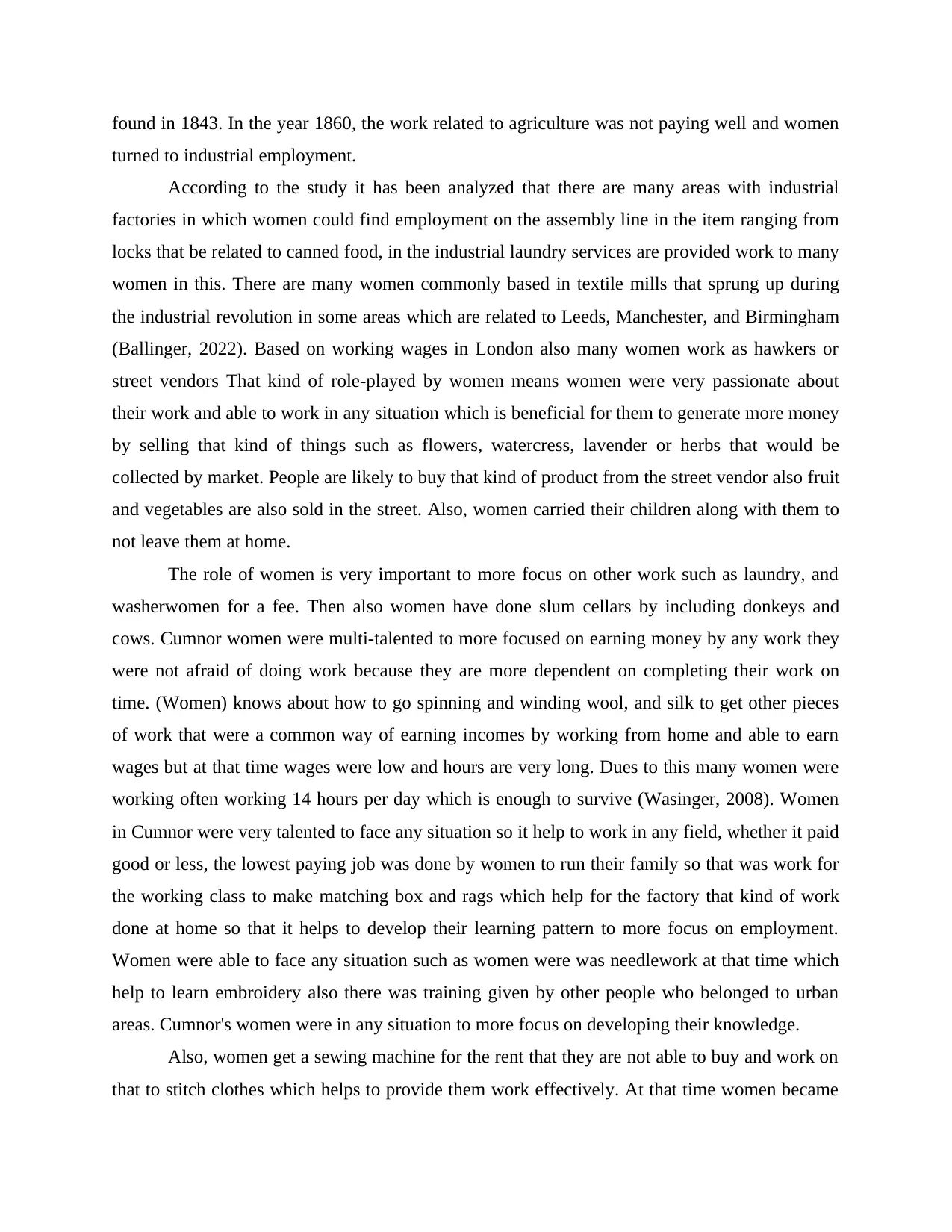
found in 1843. In the year 1860, the work related to agriculture was not paying well and women
turned to industrial employment.
According to the study it has been analyzed that there are many areas with industrial
factories in which women could find employment on the assembly line in the item ranging from
locks that be related to canned food, in the industrial laundry services are provided work to many
women in this. There are many women commonly based in textile mills that sprung up during
the industrial revolution in some areas which are related to Leeds, Manchester, and Birmingham
(Ballinger, 2022). Based on working wages in London also many women work as hawkers or
street vendors That kind of role-played by women means women were very passionate about
their work and able to work in any situation which is beneficial for them to generate more money
by selling that kind of things such as flowers, watercress, lavender or herbs that would be
collected by market. People are likely to buy that kind of product from the street vendor also fruit
and vegetables are also sold in the street. Also, women carried their children along with them to
not leave them at home.
The role of women is very important to more focus on other work such as laundry, and
washerwomen for a fee. Then also women have done slum cellars by including donkeys and
cows. Cumnor women were multi-talented to more focused on earning money by any work they
were not afraid of doing work because they are more dependent on completing their work on
time. (Women) knows about how to go spinning and winding wool, and silk to get other pieces
of work that were a common way of earning incomes by working from home and able to earn
wages but at that time wages were low and hours are very long. Dues to this many women were
working often working 14 hours per day which is enough to survive (Wasinger, 2008). Women
in Cumnor were very talented to face any situation so it help to work in any field, whether it paid
good or less, the lowest paying job was done by women to run their family so that was work for
the working class to make matching box and rags which help for the factory that kind of work
done at home so that it helps to develop their learning pattern to more focus on employment.
Women were able to face any situation such as women were was needlework at that time which
help to learn embroidery also there was training given by other people who belonged to urban
areas. Cumnor's women were in any situation to more focus on developing their knowledge.
Also, women get a sewing machine for the rent that they are not able to buy and work on
that to stitch clothes which helps to provide them work effectively. At that time women became
turned to industrial employment.
According to the study it has been analyzed that there are many areas with industrial
factories in which women could find employment on the assembly line in the item ranging from
locks that be related to canned food, in the industrial laundry services are provided work to many
women in this. There are many women commonly based in textile mills that sprung up during
the industrial revolution in some areas which are related to Leeds, Manchester, and Birmingham
(Ballinger, 2022). Based on working wages in London also many women work as hawkers or
street vendors That kind of role-played by women means women were very passionate about
their work and able to work in any situation which is beneficial for them to generate more money
by selling that kind of things such as flowers, watercress, lavender or herbs that would be
collected by market. People are likely to buy that kind of product from the street vendor also fruit
and vegetables are also sold in the street. Also, women carried their children along with them to
not leave them at home.
The role of women is very important to more focus on other work such as laundry, and
washerwomen for a fee. Then also women have done slum cellars by including donkeys and
cows. Cumnor women were multi-talented to more focused on earning money by any work they
were not afraid of doing work because they are more dependent on completing their work on
time. (Women) knows about how to go spinning and winding wool, and silk to get other pieces
of work that were a common way of earning incomes by working from home and able to earn
wages but at that time wages were low and hours are very long. Dues to this many women were
working often working 14 hours per day which is enough to survive (Wasinger, 2008). Women
in Cumnor were very talented to face any situation so it help to work in any field, whether it paid
good or less, the lowest paying job was done by women to run their family so that was work for
the working class to make matching box and rags which help for the factory that kind of work
done at home so that it helps to develop their learning pattern to more focus on employment.
Women were able to face any situation such as women were was needlework at that time which
help to learn embroidery also there was training given by other people who belonged to urban
areas. Cumnor's women were in any situation to more focus on developing their knowledge.
Also, women get a sewing machine for the rent that they are not able to buy and work on
that to stitch clothes which helps to provide them work effectively. At that time women became
Paraphrase This Document
Need a fresh take? Get an instant paraphrase of this document with our AI Paraphraser
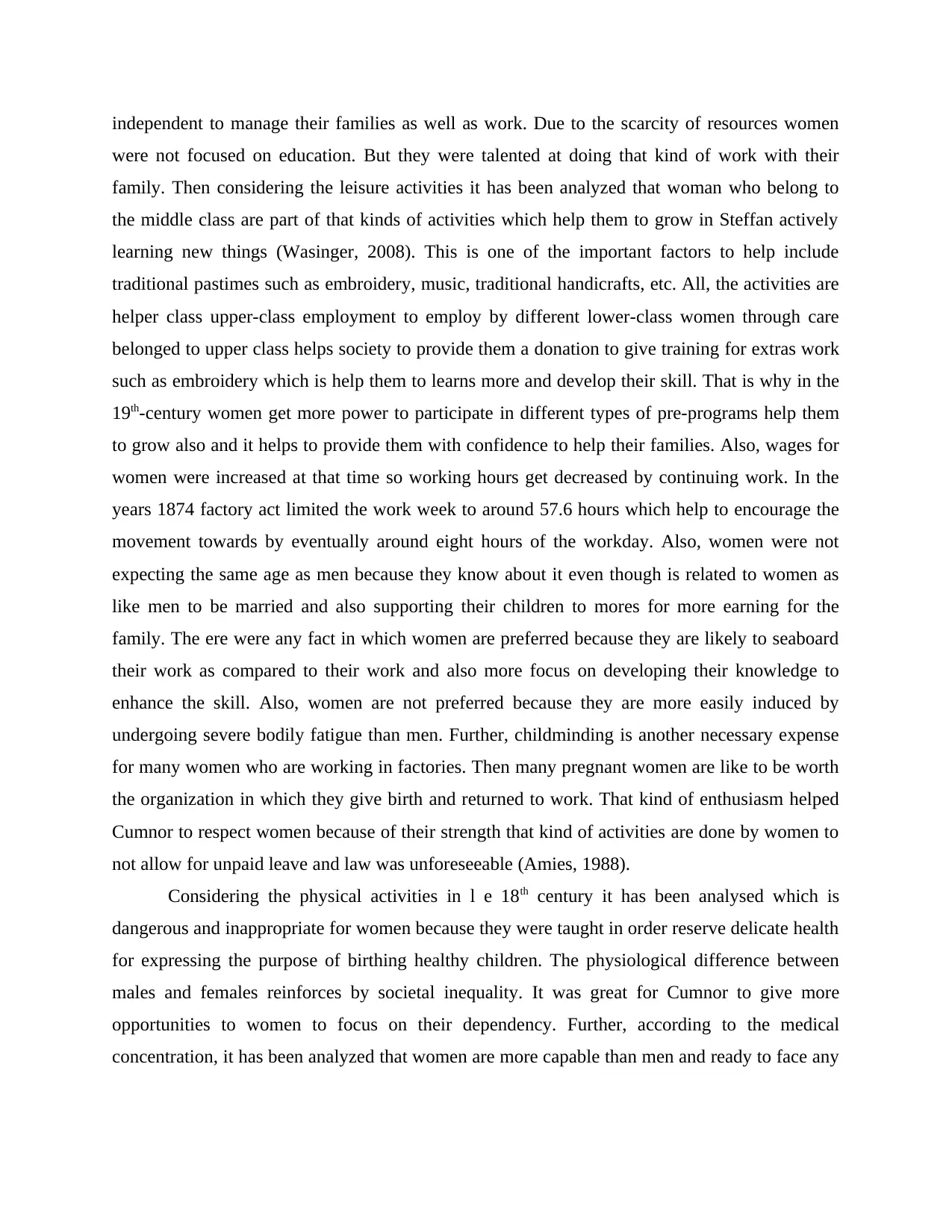
independent to manage their families as well as work. Due to the scarcity of resources women
were not focused on education. But they were talented at doing that kind of work with their
family. Then considering the leisure activities it has been analyzed that woman who belong to
the middle class are part of that kinds of activities which help them to grow in Steffan actively
learning new things (Wasinger, 2008). This is one of the important factors to help include
traditional pastimes such as embroidery, music, traditional handicrafts, etc. All, the activities are
helper class upper-class employment to employ by different lower-class women through care
belonged to upper class helps society to provide them a donation to give training for extras work
such as embroidery which is help them to learns more and develop their skill. That is why in the
19th-century women get more power to participate in different types of pre-programs help them
to grow also and it helps to provide them with confidence to help their families. Also, wages for
women were increased at that time so working hours get decreased by continuing work. In the
years 1874 factory act limited the work week to around 57.6 hours which help to encourage the
movement towards by eventually around eight hours of the workday. Also, women were not
expecting the same age as men because they know about it even though is related to women as
like men to be married and also supporting their children to mores for more earning for the
family. The ere were any fact in which women are preferred because they are likely to seaboard
their work as compared to their work and also more focus on developing their knowledge to
enhance the skill. Also, women are not preferred because they are more easily induced by
undergoing severe bodily fatigue than men. Further, childminding is another necessary expense
for many women who are working in factories. Then many pregnant women are like to be worth
the organization in which they give birth and returned to work. That kind of enthusiasm helped
Cumnor to respect women because of their strength that kind of activities are done by women to
not allow for unpaid leave and law was unforeseeable (Amies, 1988).
Considering the physical activities in l e 18th century it has been analysed which is
dangerous and inappropriate for women because they were taught in order reserve delicate health
for expressing the purpose of birthing healthy children. The physiological difference between
males and females reinforces by societal inequality. It was great for Cumnor to give more
opportunities to women to focus on their dependency. Further, according to the medical
concentration, it has been analyzed that women are more capable than men and ready to face any
were not focused on education. But they were talented at doing that kind of work with their
family. Then considering the leisure activities it has been analyzed that woman who belong to
the middle class are part of that kinds of activities which help them to grow in Steffan actively
learning new things (Wasinger, 2008). This is one of the important factors to help include
traditional pastimes such as embroidery, music, traditional handicrafts, etc. All, the activities are
helper class upper-class employment to employ by different lower-class women through care
belonged to upper class helps society to provide them a donation to give training for extras work
such as embroidery which is help them to learns more and develop their skill. That is why in the
19th-century women get more power to participate in different types of pre-programs help them
to grow also and it helps to provide them with confidence to help their families. Also, wages for
women were increased at that time so working hours get decreased by continuing work. In the
years 1874 factory act limited the work week to around 57.6 hours which help to encourage the
movement towards by eventually around eight hours of the workday. Also, women were not
expecting the same age as men because they know about it even though is related to women as
like men to be married and also supporting their children to mores for more earning for the
family. The ere were any fact in which women are preferred because they are likely to seaboard
their work as compared to their work and also more focus on developing their knowledge to
enhance the skill. Also, women are not preferred because they are more easily induced by
undergoing severe bodily fatigue than men. Further, childminding is another necessary expense
for many women who are working in factories. Then many pregnant women are like to be worth
the organization in which they give birth and returned to work. That kind of enthusiasm helped
Cumnor to respect women because of their strength that kind of activities are done by women to
not allow for unpaid leave and law was unforeseeable (Amies, 1988).
Considering the physical activities in l e 18th century it has been analysed which is
dangerous and inappropriate for women because they were taught in order reserve delicate health
for expressing the purpose of birthing healthy children. The physiological difference between
males and females reinforces by societal inequality. It was great for Cumnor to give more
opportunities to women to focus on their dependency. Further, according to the medical
concentration, it has been analyzed that women are more capable than men and ready to face any
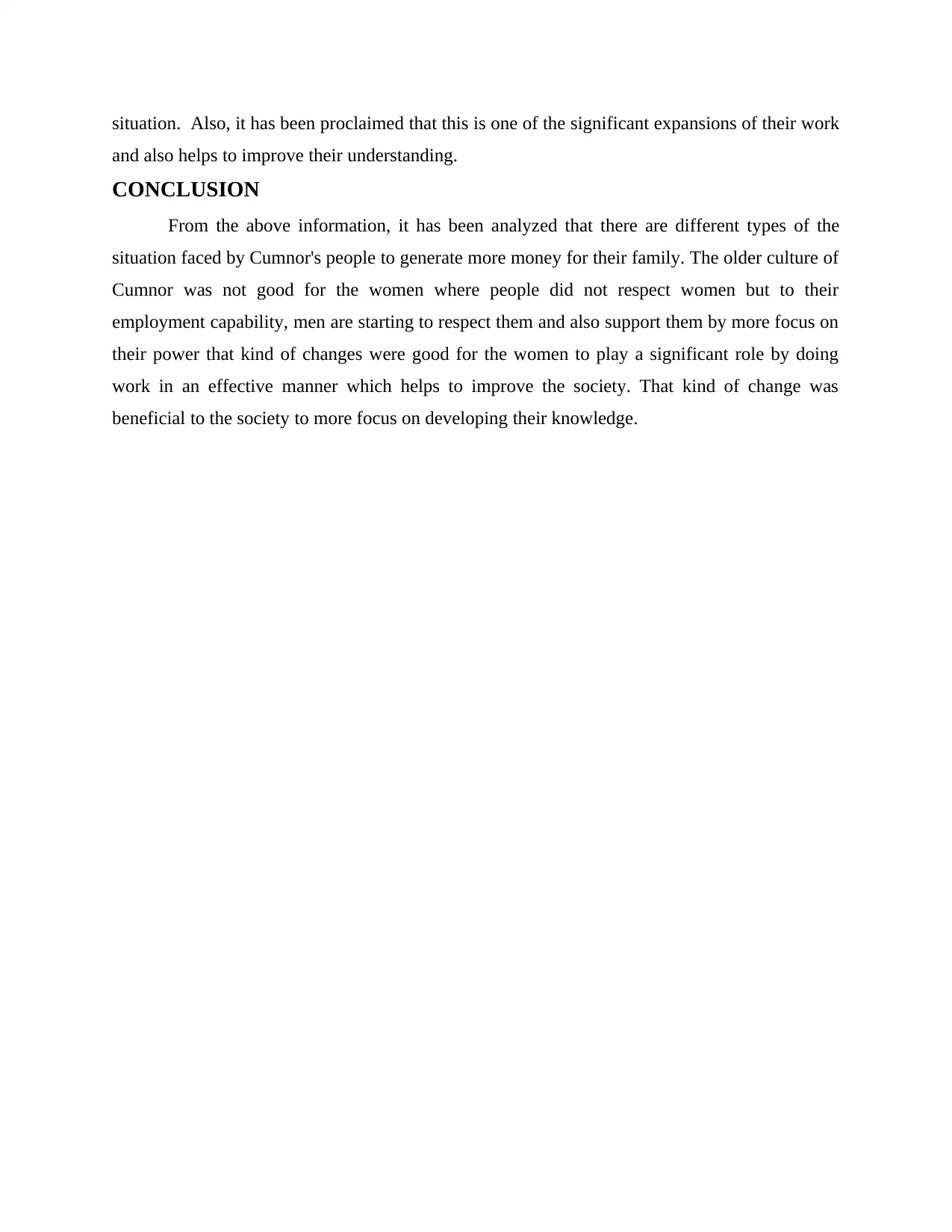
situation. Also, it has been proclaimed that this is one of the significant expansions of their work
and also helps to improve their understanding.
CONCLUSION
From the above information, it has been analyzed that there are different types of the
situation faced by Cumnor's people to generate more money for their family. The older culture of
Cumnor was not good for the women where people did not respect women but to their
employment capability, men are starting to respect them and also support them by more focus on
their power that kind of changes were good for the women to play a significant role by doing
work in an effective manner which helps to improve the society. That kind of change was
beneficial to the society to more focus on developing their knowledge.
and also helps to improve their understanding.
CONCLUSION
From the above information, it has been analyzed that there are different types of the
situation faced by Cumnor's people to generate more money for their family. The older culture of
Cumnor was not good for the women where people did not respect women but to their
employment capability, men are starting to respect them and also support them by more focus on
their power that kind of changes were good for the women to play a significant role by doing
work in an effective manner which helps to improve the society. That kind of change was
beneficial to the society to more focus on developing their knowledge.
⊘ This is a preview!⊘
Do you want full access?
Subscribe today to unlock all pages.

Trusted by 1+ million students worldwide
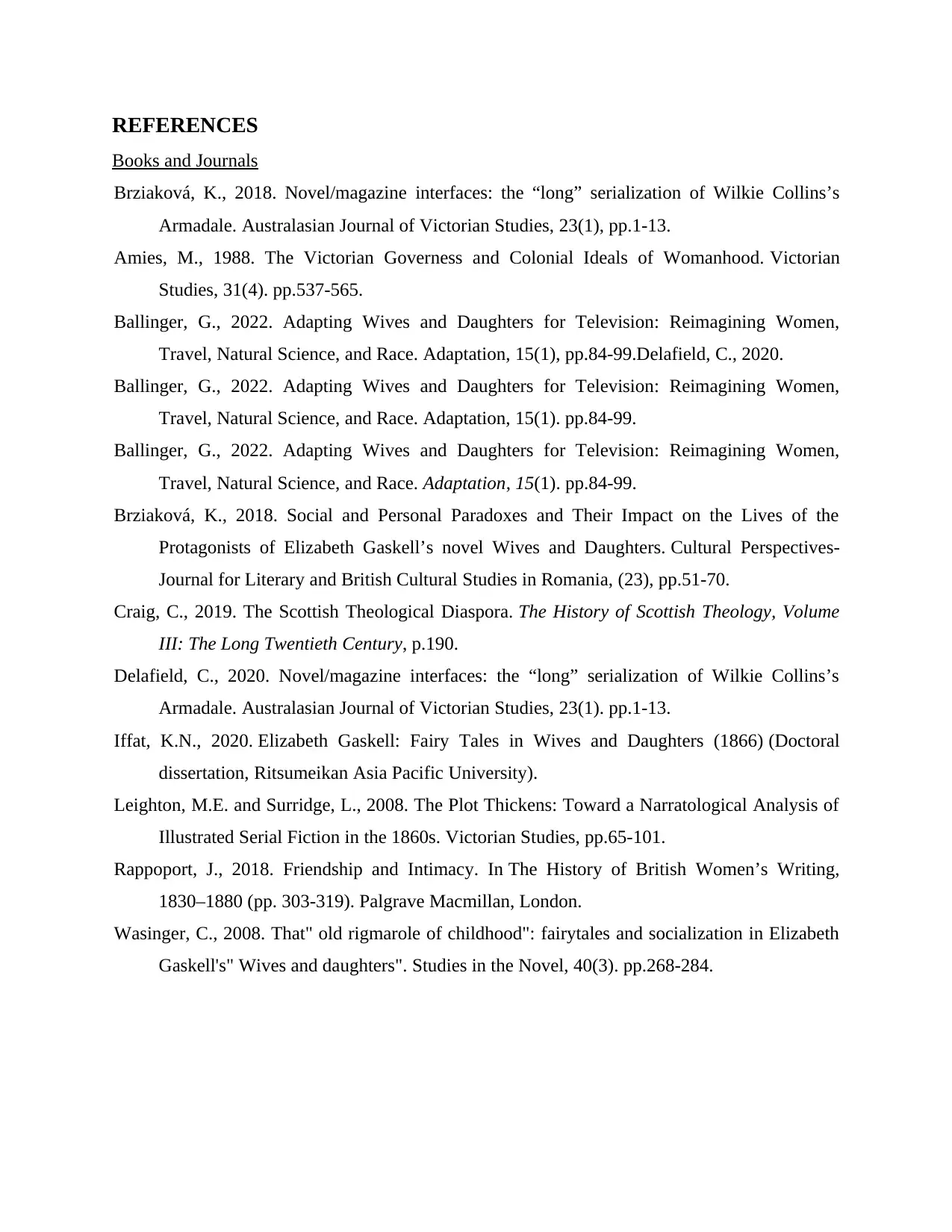
REFERENCES
Books and Journals
Brziaková, K., 2018. Novel/magazine interfaces: the “long” serialization of Wilkie Collins’s
Armadale. Australasian Journal of Victorian Studies, 23(1), pp.1-13.
Amies, M., 1988. The Victorian Governess and Colonial Ideals of Womanhood. Victorian
Studies, 31(4). pp.537-565.
Ballinger, G., 2022. Adapting Wives and Daughters for Television: Reimagining Women,
Travel, Natural Science, and Race. Adaptation, 15(1), pp.84-99.Delafield, C., 2020.
Ballinger, G., 2022. Adapting Wives and Daughters for Television: Reimagining Women,
Travel, Natural Science, and Race. Adaptation, 15(1). pp.84-99.
Ballinger, G., 2022. Adapting Wives and Daughters for Television: Reimagining Women,
Travel, Natural Science, and Race. Adaptation, 15(1). pp.84-99.
Brziaková, K., 2018. Social and Personal Paradoxes and Their Impact on the Lives of the
Protagonists of Elizabeth Gaskell’s novel Wives and Daughters. Cultural Perspectives-
Journal for Literary and British Cultural Studies in Romania, (23), pp.51-70.
Craig, C., 2019. The Scottish Theological Diaspora. The History of Scottish Theology, Volume
III: The Long Twentieth Century, p.190.
Delafield, C., 2020. Novel/magazine interfaces: the “long” serialization of Wilkie Collins’s
Armadale. Australasian Journal of Victorian Studies, 23(1). pp.1-13.
Iffat, K.N., 2020. Elizabeth Gaskell: Fairy Tales in Wives and Daughters (1866) (Doctoral
dissertation, Ritsumeikan Asia Pacific University).
Leighton, M.E. and Surridge, L., 2008. The Plot Thickens: Toward a Narratological Analysis of
Illustrated Serial Fiction in the 1860s. Victorian Studies, pp.65-101.
Rappoport, J., 2018. Friendship and Intimacy. In The History of British Women’s Writing,
1830–1880 (pp. 303-319). Palgrave Macmillan, London.
Wasinger, C., 2008. That" old rigmarole of childhood": fairytales and socialization in Elizabeth
Gaskell's" Wives and daughters". Studies in the Novel, 40(3). pp.268-284.
Books and Journals
Brziaková, K., 2018. Novel/magazine interfaces: the “long” serialization of Wilkie Collins’s
Armadale. Australasian Journal of Victorian Studies, 23(1), pp.1-13.
Amies, M., 1988. The Victorian Governess and Colonial Ideals of Womanhood. Victorian
Studies, 31(4). pp.537-565.
Ballinger, G., 2022. Adapting Wives and Daughters for Television: Reimagining Women,
Travel, Natural Science, and Race. Adaptation, 15(1), pp.84-99.Delafield, C., 2020.
Ballinger, G., 2022. Adapting Wives and Daughters for Television: Reimagining Women,
Travel, Natural Science, and Race. Adaptation, 15(1). pp.84-99.
Ballinger, G., 2022. Adapting Wives and Daughters for Television: Reimagining Women,
Travel, Natural Science, and Race. Adaptation, 15(1). pp.84-99.
Brziaková, K., 2018. Social and Personal Paradoxes and Their Impact on the Lives of the
Protagonists of Elizabeth Gaskell’s novel Wives and Daughters. Cultural Perspectives-
Journal for Literary and British Cultural Studies in Romania, (23), pp.51-70.
Craig, C., 2019. The Scottish Theological Diaspora. The History of Scottish Theology, Volume
III: The Long Twentieth Century, p.190.
Delafield, C., 2020. Novel/magazine interfaces: the “long” serialization of Wilkie Collins’s
Armadale. Australasian Journal of Victorian Studies, 23(1). pp.1-13.
Iffat, K.N., 2020. Elizabeth Gaskell: Fairy Tales in Wives and Daughters (1866) (Doctoral
dissertation, Ritsumeikan Asia Pacific University).
Leighton, M.E. and Surridge, L., 2008. The Plot Thickens: Toward a Narratological Analysis of
Illustrated Serial Fiction in the 1860s. Victorian Studies, pp.65-101.
Rappoport, J., 2018. Friendship and Intimacy. In The History of British Women’s Writing,
1830–1880 (pp. 303-319). Palgrave Macmillan, London.
Wasinger, C., 2008. That" old rigmarole of childhood": fairytales and socialization in Elizabeth
Gaskell's" Wives and daughters". Studies in the Novel, 40(3). pp.268-284.
1 out of 10
Your All-in-One AI-Powered Toolkit for Academic Success.
+13062052269
info@desklib.com
Available 24*7 on WhatsApp / Email
![[object Object]](/_next/static/media/star-bottom.7253800d.svg)
Unlock your academic potential
Copyright © 2020–2025 A2Z Services. All Rights Reserved. Developed and managed by ZUCOL.